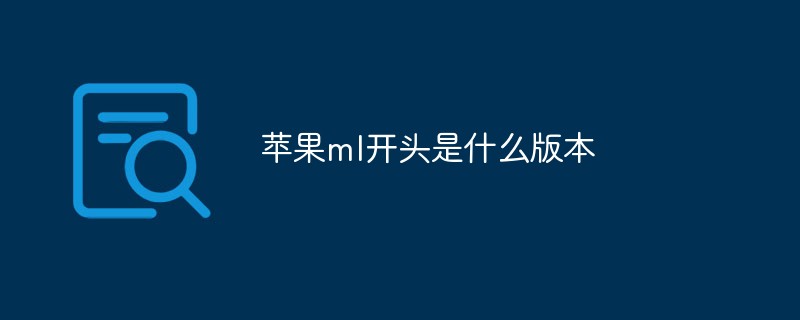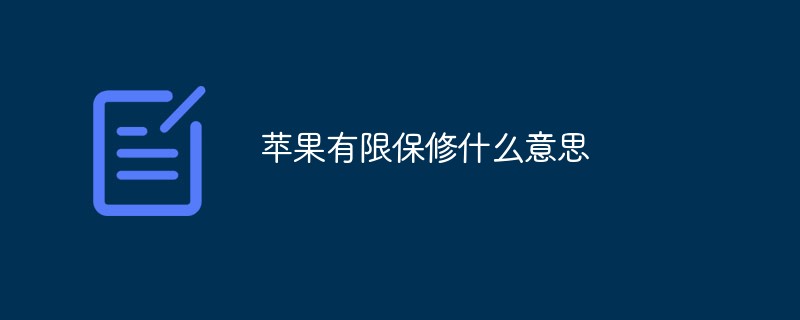When Apple launched the first Apple Watch, owning it was more of a fashion statement than anything else, and it could also display notifications from iPhopromptlyner. Since then, subsequent versions of Apple Watch have added features to help you track your health and get a complete picture of your health. One of the health features of the modern Apple Watch is the ECG app, which records your heart rhythm and looks for any abnormalities.
To detect electrical signals in your heart, Apple has integrated electrodes on the back of Apple Watch and the Digital Crown. When you touch the Digital Crown, a closed circuit is formed between your heart and arm, which allows the ECG app to measure your heartbeat and rhythm to generate an electrocardiogram.
Which Apple Watch supports electrocardiogram (ECG) measurement?
Because recording an ECG requires your Apple Watch to have an electronic heart sensor, this means the ECG app is only available on select Apple Watch models. These include:
- Apple Watch Series 4
- Apple Watch Series 5
- Apple Watch Series 6
- Apple Watch Series 7
- Apple Watch Series 8
- Apple Watch Ultra
If you have an Apple Watch Series 3, Watch SE, or an older device, you will not be able to record your heartbeat and rhythm to Make an electrocardiogram.
What do I need to use an EKG on Apple Watch?
In addition to having a compatible Apple Watch, you'll also need to make sure you meet the following requirements to record your EKG:
- You're using an iPhone 8 or newer device with your Apple Watch pair.
- The connected iPhone has been updated to the latest version of iOS.
- Your Apple Watch has been updated to the latest version of watchOS.
- You live in an area where Apple supports ECG. You can check your region from the "Brand Services: EKG" section of this page.
- Make sure you have the ECG app installed on your Apple Watch. If the app isn't available, download it directly from the App Store on your watch.
- You must be at least 22 years old to successfully read an EKG.
After meeting the above requirements, you can proceed to set up ECG on Apple Watch.
How to Set Up an ECG on Apple Watch
If this is your first time recording an ECG on your Apple Watch, you need to set it up before you can use the ECG app on your watch. The ECG feature can be enabled using the Health app on a connected iPhone, and the ECG app should appear on your Apple Watch once setup is complete.
First, please open the “Health” app on your iPhone.

In Health, you may see a prompt to set up the ECG app on your watch if you haven't already. If this prompt is not available, click the Browse tab in the lower right corner.

On the browse screen, select Heart under Health Categories.

Here, click on Electrocardiogram (ECG).

On the next screen, tap Set up ECG app, then follow the on-screen instructions to continue and enable the ECG app on your Apple Watch.

Once setup is complete, you should see the ECG app on your watch; if not, open the Watch app on your iPhone.

In Watch, scroll down and select Heart.

On the next screen, click "Install" within the "ECG" section to download the app to your Apple Watch.

How to Prepare for ECG Readings
After you enable the ECG app on your Apple Watch, you can start taking ECG readings from your wrist at any time. Before you do this, you must be prepared to successfully read your EKG. To do this, follow the necessary steps listed below to get the most accurate readings from your ECG application:
- During the recording process, do not move, especially your arms.
- For best results, place your arms on the table in your lap while the EKG is read.
- Make sure your Apple Watch fits snugly around your wrist and doesn't come loose enough that your watch makes contact with the top of your wrist. It should fit snugly, but at the same time, you want to make sure there's enough room for your skin to breathe.
- Before taking a reading, make sure your Apple Watch and wrist are clean to avoid getting inaccurate measurements.
- When taking an EKG, avoid being near other electronic devices because they may interfere with the readings if they are plugged into an electrical outlet.
- Make sure to wipe off any water or liquid from your wrist or the back of your Apple Watch, as the ECG app requires the contact surface to be dry to get an accurate reading. If you want to take an EKG reading immediately after swimming, showering, sweating, or washing your hands, drain all the water from the watch and take the reading after the watch is completely dry, preferably one hour later.
- For ECG readings to show accurate results, make sure you have your Apple Watch on your wrist and set up in Watch Orientation. To check your orientation, check your watch by going to WatchApps>My Watch>General>Watch Orientation Wear it on your right wrist or change it to your preferred orientation from this screen.
How to Read an ECG on Apple Watch
After you enable the ECG app on your watch and perform the necessary preparations to take an ECG reading, you can measure an ECG directly from your Apple Watch. First, press the Digital Crown on the right side of your Apple Watch and select ECG from the app list/grid displayed on the screen.

#When the app opens, make sure your wrist is in a resting position and flat on a table or lap. When you're ready, press the face of the Digital Crown with the fingers of your other hand. For example, if you wear your Apple Watch on your left wrist and the Digital Crown faces right, touch and hold the Digital Crown with the fingers of your right hand.

NOTE: To take a reading, you simply touch and hold the Digital Crown instead of pressing it.
When you touch the Digital Crown with your finger, the ECG app will start recording your heartbeat and rhythm to create an electrocardiogram. A recording takes 30 seconds, so you'll want to make sure you're holding the Digital Crown the entire time.

When recording starts, you'll see your heart rate in the upper left corner, followed by your heartbeat rhythm and a countdown timer.

At the end of these 30 seconds, you will see your ECG breakdown, which gives an indication of your heart health.

If the app says you are in sinus rhythm and you are not feeling any symptoms, use the Digital Crown to scroll down and tap Done to Close current reading.

If you feel unwell, you can add your symptoms to match the ECG reading by clicking "Add Symptoms".

#From the list of symptoms that appear, select the symptom you are currently feeling.

Next, click Save to confirm the changes.

What do my EKG readings show?
When you take a successful reading using the ECG app, you'll see different classifications based on the heartbeats and rhythms detected by your Apple Watch. The ECG app can show you five types of classifications based on your readings. These include:
- Sinus Rhythm: Ideally, for most people, you should see this classification after the ECG app takes your readings. Getting this result means your heart rate is between 50 and 100 BPM and your heart is beating in an even pattern. A regular display of sinus rhythm indicates that the upper and lower chambers of your heart are beating in sync.
- Atrial Fibrillation: Also known as AFib, this result means your heart beats in an irregular pattern. If you receive an AFib classification on your ECG app, you may have a serious arrhythmia, or irregular heartbeat. If you haven't been diagnosed with AFib, you should talk to your doctor about this reading and get further testing. The ECG app can check for atrial fibrillation between 50 and 150 BPM in app version 2 and between 50 and 120 BPM in app version 1. The version of the app you use depends on your country's restrictions on ECG functionality, you can check which version of the ECG app you have by going to Settings > Heart > ECG on your Apple Watch. You can also check on your iPhone by going to Health > Browse > Heart > EKG > About.
- Low or high heart rate: If your heart rate is below 50 BPM or above 150 BPM in ECG version 2 (or 120 BPM in version 1), the ECG app Will display your readings as low heart rate or high heart rate. When this classification occurs, the ECG application will not be able to check for AFib. You may see a low heart rate as a result of certain medications when electrical signals are not conducted properly through the heart, or if you are an elite athlete. A high heart rate can be caused by exercise, stress, tension, alcohol, dehydration, infection, AFib, or other cardiac arrhythmias.
- Inconclusive: If your ECG reading shows inconclusive, it means the record cannot be classified. This may occur if your heart rate is found to be between 100 and 120 BPM on ECG app version 1 with no signs of AFib. Other reasons for this result could be because you have certain heart conditions or certain arrhythmias, or you have a pacemaker or ICD. For some users, readings may be inconclusive if their physiological condition prevents the app from generating an adequate electrical signal. If you don't have any of these symptoms, your Apple Watch may be too loose on your wrist, preventing accurate readings.
- RecordPoor: You will only see this classification on ECG app version 2, which essentially indicates that your Apple Watch cannot read data from your wrist A successful reading was obtained. To prevent this result, follow the steps in the "How to Prepare for an EKG Reading" section above before preparing for another reading.
How to View ECG Readings from Apple Watch
When you take an ECG reading, you should be able to see the results directly on your Apple Watch. However, this result only shows your reading category and average heart rate over a 30-second period. Additionally, you will not be able to view previous ECG readings through the ECG app on your watch. This is where the Health app on your iPhone comes in handy, as it allows you to view your readings. To see more details about your last ECG reading, you can tap on your iPhone's Alerts for
ECG records received are available on the Lock screen or Notification Center, which appear as soon as the ECG app has finished reading.
If you want to view previous ECG readings, you can first open the " Health" app on your iPhone.
Health" app on your iPhone.
In Health, check the  Electrocardiogram (ECG) section of the Summary screen.
Electrocardiogram (ECG) section of the Summary screen.
If you can't find it, please click the " Browse" tab in the lower right corner.
Browse" tab in the lower right corner.
On this screen, click  Heart under the Health Category.
Heart under the Health Category.
#Here you should see the Electrocardiogram (ECG) section under the current date or a previous date. This section will show you the last recorded category and the date or dates of the last ECG collection. To view all of your previously recorded ECGs, click  Electrocardiogram (ECG) on this screen.
Electrocardiogram (ECG) on this screen.
On the Electrocardiogram (ECG) screen, you'll see a list of all your previous ECG readings. You can scroll through the readings to see their categories, average heart rate, and heartbeat graphs. You can click read to see more details.

When you select a reading from the electrocardiogram (ECG) screen, you will see a detailed heartbeat graph dragged to the right.

You can scroll down to see the reading’s start/end time, source, version, watch model, and software version.

If you want to share the record with a doctor or others, click Export PDF below the ECG.

The next screen will show your heartbeat in 3 different graphs, 10 seconds each, along with the ECG classification and your average heart rate. To share this form with your friends, family, or doctor, click the Share icon in the upper right corner.

#In the share sheet that appears, click the app or person you want to share the ECG record with. You can also keep an electronic copy of your ECG readings on your iPhone by selecting "Save to File" .

If the ECG readings show inaccurate results, or you used the watch to record someone else's ECG, you can resolve the issue by turning on the unwanted ECG reading in the ECG Details screen Scroll down and click Delete Record to delete it from your ECG history.

In the next prompt, click Delete to confirm the changes.

#You can view all ECGs from the Health app’s home screen by adding them to your favorites. To do this, go to the electrocardiogram (ECG) screen on the Health app, scroll down, and tap Add to Favorites.

When you do this, you will see a blue star icon on the right indicating that the ECG section has been added to Favorites on the Summary screen "middle.
The above is the detailed content of Record an ECG on Apple Watch: A step-by-step guide. For more information, please follow other related articles on the PHP Chinese website!
 苹果序列号d开头什么意思Dec 27, 2022 pm 03:38 PM
苹果序列号d开头什么意思Dec 27, 2022 pm 03:38 PM苹果序列号d开头代表该手机是成都富士康生产的。苹果手机的序列号有自己的意义,其第一位代表生产地,第二和第三位代表生产线,第四和第五位代表生产年份和周期,第六、七和八位是产品唯一识别符,第九和第十位代表型号,第十一和第十二位代表颜色和容量。序列号第一位代表生产地:1、F代表河南郑州;2、D代表四川成都;3、C代表广东深圳;4、G0代表上海和硕;5、G6代表深圳富士康新生产线。
 苹果xs max是几代Nov 03, 2022 pm 04:58 PM
苹果xs max是几代Nov 03, 2022 pm 04:58 PM苹果xs max是苹果第十二代。“X”是罗马数字中的10,“X”代表苹果向iPhone问世十周年的致敬;2017年9月13日,iPhone X正式发布,该产品为苹果第十一代产品;iPhone XS Max是2018年9月13日发布的,为第十二代苹果手机。
 苹果13分辨率是2k吗Dec 14, 2022 pm 05:48 PM
苹果13分辨率是2k吗Dec 14, 2022 pm 05:48 PM苹果13分辨率不是2k;2K分辨率为“2560*1440”,而苹果13的分辨率为“2532x1170”,所以不是2K的。苹果13是苹果公司于北京时间2021年9月15日发布的i智能手机,采用6.1英寸OLED屏幕,屏幕分辨率为2532x1170像素,屏幕亮度达到了800尼特,HDR模式下峰值亮度可达到1200尼特。
 苹果刷机有啥影响吗Dec 26, 2022 am 11:09 AM
苹果刷机有啥影响吗Dec 26, 2022 am 11:09 AM苹果刷机的影响有:1、可能导致手机恢复出厂设置,变成全英文系统,或者是无法开机,功能失效等后果;2、刷机后就会不保修;3、频繁刷机会对手机的硬件造成一定的损害,从而减少手机的使用寿命。
 苹果ml开头是什么版本Nov 07, 2022 pm 03:40 PM
苹果ml开头是什么版本Nov 07, 2022 pm 03:40 PM苹果ml开头是苹果零售机版本,即正常渠道销售的手机,在手机行业中被叫做原封机。零售机是苹果公司用来放在直营店和授权店出售的机器,含有全套全新配件;此类机器就是你到苹果官网、Apple Store或者苹果经销商等正规渠道购得,以上三种渠道购得的零售机,都是具有增值税发票的。
 苹果可以双卡双待的机型有哪些Dec 27, 2022 pm 04:19 PM
苹果可以双卡双待的机型有哪些Dec 27, 2022 pm 04:19 PM苹果可以双卡双待的机型有iPhone XS Max、iPhone XR、iPhone 11、iPhone 11 Pro、iPhone 11 Pro Max、iPhone 12、iPhone 12 Pro、iPhone 12 Pro Max、iPhone 13、iPhone 13 Pro、iPhone 13 Pro Max、iPhone 14等。
 苹果轻app是什么意思Dec 22, 2022 pm 05:31 PM
苹果轻app是什么意思Dec 22, 2022 pm 05:31 PM轻app的英文全名为“Light APP”,是一个比较轻量化的app,是让用户可以权用较小的存储空间就使用到软件的核心功能。轻APP是基于平台级移动应用;开发速度快、占用系统资源少,无需下载,即可使用。有点像微信和支付宝里的小程序功能。用户可以在Safari浏览器、“地图”、“信息”中发现轻App;同时可以通过NFC标签、二维码、轻App码来发现轻App。
 苹果有限保修什么意思Dec 02, 2022 pm 03:38 PM
苹果有限保修什么意思Dec 02, 2022 pm 03:38 PM苹果有限保修是指制造商根据合同有义务更换在产品寿命期间损坏或有缺陷的产品部件,但是制造商在法律上没有义务更换保修中未提及的部件,或者被消费者损坏或误用的部件。

Hot AI Tools

Undresser.AI Undress
AI-powered app for creating realistic nude photos

AI Clothes Remover
Online AI tool for removing clothes from photos.

Undress AI Tool
Undress images for free

Clothoff.io
AI clothes remover

AI Hentai Generator
Generate AI Hentai for free.

Hot Article

Hot Tools

Dreamweaver Mac version
Visual web development tools

SublimeText3 Chinese version
Chinese version, very easy to use

SublimeText3 Mac version
God-level code editing software (SublimeText3)

SublimeText3 English version
Recommended: Win version, supports code prompts!

DVWA
Damn Vulnerable Web App (DVWA) is a PHP/MySQL web application that is very vulnerable. Its main goals are to be an aid for security professionals to test their skills and tools in a legal environment, to help web developers better understand the process of securing web applications, and to help teachers/students teach/learn in a classroom environment Web application security. The goal of DVWA is to practice some of the most common web vulnerabilities through a simple and straightforward interface, with varying degrees of difficulty. Please note that this software







